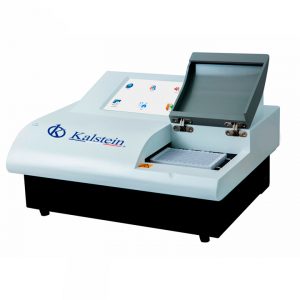Hepatitis B is an infectious and contagious disease, caused by the hepatitis B virus or HBV, that causes damage and inflammation in the liver. It is spread through contact with the blood or body fluids of the person carrying it. This virus can cause acute or chronic infection, the latter being the most serious and the one that has no cure, however, there are treatments to slow the damage caused by the virus to the liver.
Hepatitis B becomes chronic when the body does not have the ability to fight the virus, this is more likely to happen if the infection was acquired at a young age through the mother. Hepatitis B infection can be prevented by vaccination and safe sex.
The HBsAg ELISA, a qualitative enzyme immunoassay used to detect HBsAg (Hepatitis B Surface Antigen) antigen, can be used to determine whether a person is infected by holding a sample in serum or plasma. For this, an ELISA microplate reader is needed to evaluate the result of this test.
Principle of the diagnosis of hepatitis B by ELISA microplate reader
The HBsAg ELISA test is an immunoenzymatic technique that uses the sandwich principle to determine, in plasma or serum, the Virus Surface Antigen (HBsAg), i.e., the Hepatitis B antigen. As the test is performed, the sample and the HBsAg antibodies entwined to an enzyme are deposited in monoclonal antibody-covered microwells and incubated. If the sample contains HBsAg, a complex will be created with the antibody.
After incubation, which is done initially in the microwells, they must be washed to remove unbound material. Later, substrate A and B are added and incubated again, as a result a blue hue is generated, which indicates the amount of HBsAg found in the sample. To stop the reaction, sulfuric acid is incorporated into the microwells, which will turn the color from blue to yellow. The ELISA microplate reader will measure the color intensity, corresponding to the concentration of HbsAg in the sample.
Benefits of the ELISA microplate reader in the diagnosis of hepatitis B
The microplate reader is a device used to make fluorescence, absorbance and luminescence measurements. This tool saves costs and minimizes operating time, allowing researchers to focus on analyzing data. On the other hand, the sandwich ELISA used in the diagnosis of hepatitis B has the following advantages:
- It’s simple and fast.
- Multimodal.
- High flexibility, can use direct and indirect ELISA protocol.
- Highly sensitive and specific.
Microplate Readers
A microplate reader, also known as a microplate photometer, is a laboratory instrument that is responsible for detecting physical, biological, or chemical events in a sample. As a multimodal team, you can run different types of experiments at the same time. The main functions are to perform luminescence, fluorescence and absorbance measurements.
This microplate reader is composed of microwells used to deposit the sample to be analyzed, being the ELISA test one of the most common tasks performed by this team, which allows detecting antigens in the blood. This test can be used to diagnose diseases such as HIV, dengue, hepatitis B, yellow fever and others related to the area of serology and immunology.
Kalstein brand microplate reader
At Kalstein we are known to be MANUFACTURERS of different laboratory equipment of great utility in the area of science. What characterizes our equipment as the best, are its high technology and quality, in addition to having PRICES accessible to all pockets. If you are looking for microplate readers, in our catalog you can find all kinds of models, such as microplate readers and Elisa readers. Our YR series Elisa reader features:
- Windows operation interface, figure button, mouse operation, touch screen.
- 96-well plate, multiple tests on a single plate.
- The arrangement of the test item on the microplate can be stored.
- The parameter can be modified and stored.
If you wish to make the PURCHASE of our microplate readers, you can enter by clicking the following link: HERE

